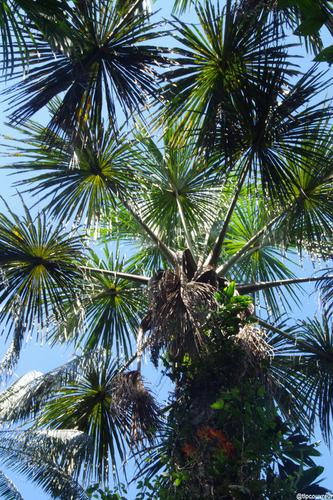当前位置:
X-MOL 学术
›
Biotropica
›
论文详情
Our official English website, www.x-mol.net, welcomes your feedback! (Note: you will need to create a separate account there.)
High genetic diversity with low connectivity among Mauritia flexuosa (Arecaceae) stands from Ecuadorean Amazonia
Biotropica ( IF 2.1 ) Pub Date : 2020-10-07 , DOI: 10.1111/btp.12855 Rommel Montúfar 1 , Andrés Recalde 1 , Thomas L. P. Couvreur 1, 2
Biotropica ( IF 2.1 ) Pub Date : 2020-10-07 , DOI: 10.1111/btp.12855 Rommel Montúfar 1 , Andrés Recalde 1 , Thomas L. P. Couvreur 1, 2
Affiliation

|
Mauritia flexuosa dominated palm swamps are an important forest resource covering over 30,000 km2 across the Amazon basin. In Ecuadorean Amazonia, Mauritia flexuosa, a dioecious and arborescent palm species, forms small and isolated populations or large and dense stands on poorly drained soils. How these populations are genetically interconnected and how genetic diversity varies between cohorts of different ages remains little studied although they are important for conservation of these ecosystems. The genetic structure of Mauritia flexuosa was studied in five natural stands using eight microsatellite loci and two cohorts (seedling and adults). In addition, age structure and sex ratio within the stands were assessed using transects. The age structure of the studied Mauritia flexuosa stands is represented by a high number of seedlings (mean = 1,153.6/ha) and adults (mean = 563.2/ha), with a sex ratio favoring female individuals (1.42:1). These stands are also characterized by a fine‐scale genetic structure, high observed heterozygosity (mean: HO seedlings=0.52; HO adults=0.52), high inbreeding (mean: FIS seedlings = 0.26; FIS adults = 0.26), low number of migrants (Nm=0.29), strong genetic differentiation (mean: pairwise RST/ D‐values seedlings = 0.08/ 0.74; mean RST/D‐values adults = 0.17/ 0.76), and an average effective population size (Ne) of 191.42 individuals. No intergenerational genetic variation was detected between seedlings and adults. We suggest that the high genetic diversity and inbreeding as well as the strong differentiation among stands of these populations could be explained, at least partially, by a low genetic connectivity among populations. Destructive harvesting of its fruits and defaunation will be major threats to Mauritia flexuosa populations in the future.
中文翻译:

厄瓜多尔亚马孙草(Mauritia flexuosa(Arecaceae))之间的遗传多样性高而连通性低
柔毛毛栗虫为主的棕榈沼泽是一种重要的森林资源,覆盖整个亚马逊河流域超过30,000 km 2。在厄瓜多尔的亚马孙地区,柔毛毛毛虫(雌雄同株,树状雌雄异株)在排水不畅的土壤上形成的小而孤立的种群或大而茂密的林分。这些种群如何在遗传上相互联系,以及不同年龄人群之间遗传多样性如何变化,尽管它们对于保护这些生态系统很重要。柔毛毛毛虫的遗传结构使用八个微卫星基因座和两个队列(幼苗和成年)在五个天然林中进行了研究。此外,还使用样条对林分内的年龄结构和性别比进行了评估。所研究的年龄结构曲叶矛榈看台由大量幼苗(平均= 1,153.6 /公顷)和成年人(平均= 563.2 /公顷)表示,具有性别比率有利于女性个体(1.42:1)。这些支架的特征还在于一个精细尺度遗传结构,高观察杂(平均:^ h ø苗= 0.52; ħ ö成人= 0.52),高近亲繁殖(平均:˚F IS苗 = 0.26; ˚F IS成人 = 0.26),移民人数少(N m= 0.29),强大的遗传分化能力(均值:成对的R ST / D值幼苗 = 0.08 / 0.74;成年的R ST / D值平均值 = 0.17 / 0.76),平均有效种群数量(N e)为191.42个人。在幼苗和成年之间未检测到代际遗传变异。我们认为,这些种群的林分之间的高度遗传多样性和近亲繁殖以及强烈的分化可以至少部分地通过种群之间的低遗传联系来解释。其果实的破坏性收获和毁灭性将是今后对柔毛毛里求斯人种群的主要威胁。
更新日期:2020-10-07
中文翻译:

厄瓜多尔亚马孙草(Mauritia flexuosa(Arecaceae))之间的遗传多样性高而连通性低
柔毛毛栗虫为主的棕榈沼泽是一种重要的森林资源,覆盖整个亚马逊河流域超过30,000 km 2。在厄瓜多尔的亚马孙地区,柔毛毛毛虫(雌雄同株,树状雌雄异株)在排水不畅的土壤上形成的小而孤立的种群或大而茂密的林分。这些种群如何在遗传上相互联系,以及不同年龄人群之间遗传多样性如何变化,尽管它们对于保护这些生态系统很重要。柔毛毛毛虫的遗传结构使用八个微卫星基因座和两个队列(幼苗和成年)在五个天然林中进行了研究。此外,还使用样条对林分内的年龄结构和性别比进行了评估。所研究的年龄结构曲叶矛榈看台由大量幼苗(平均= 1,153.6 /公顷)和成年人(平均= 563.2 /公顷)表示,具有性别比率有利于女性个体(1.42:1)。这些支架的特征还在于一个精细尺度遗传结构,高观察杂(平均:^ h ø苗= 0.52; ħ ö成人= 0.52),高近亲繁殖(平均:˚F IS苗 = 0.26; ˚F IS成人 = 0.26),移民人数少(N m= 0.29),强大的遗传分化能力(均值:成对的R ST / D值幼苗 = 0.08 / 0.74;成年的R ST / D值平均值 = 0.17 / 0.76),平均有效种群数量(N e)为191.42个人。在幼苗和成年之间未检测到代际遗传变异。我们认为,这些种群的林分之间的高度遗传多样性和近亲繁殖以及强烈的分化可以至少部分地通过种群之间的低遗传联系来解释。其果实的破坏性收获和毁灭性将是今后对柔毛毛里求斯人种群的主要威胁。


























 京公网安备 11010802027423号
京公网安备 11010802027423号